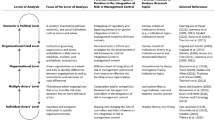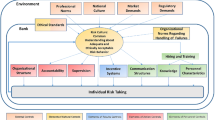Abstract
Purpose
The risk environment within organizations and business groups has been identified as a key factor in preventing scandal, unexpected losses, and even insolvency in financial institutions. The objective of this paper is to propose a multilevel framework for investigating risk climate (the shared perceptions among employees of the relative priority given to risk management, including perceptions of the risk-related practices and behaviors that are expected, valued and supported), together with its outcomes and antecedents, and validate a new measure.
Design/Methodology/Approach
A bottom-up phenomenon-driven process was used in scale development. We drew on published case studies, the industry literature, and interviews with subject matter experts. We performed three studies across a total of 10,544 employees in three different banks based in different countries. An online survey methodology was used to first explore and then confirm the factor structure, fit and invariance of our risk climate measure at the individual level of analysis, before progressing to examine fit and invariance across both the individual and business unit level simultaneously.
Findings
We found evidence for four unique factors of risk climate that were invariant across three organizations, two countries, and two levels of analysis (individual and business unit).
Implications
The risk climate scale presented in this paper provides a means by which senior leaders of financial institutions may better understand risk climate and how it varies at the business unit level. This information is relevant both to meet regulatory requirements and as a guide for potential intervention to strengthen or change risk climate.
Originality/Value
This paper provides the first academic study of a new strategic-focused climate construct based on the relative priority given to risk management.

Similar content being viewed by others
Notes
International Organisation for Standardisation is an independent NGO representing national standards bodies of 162 countries. See www.iso.org/iso/home/standards/iso31000.htm for risk management standards.
References
Anderson, N. R., & West, M. A. (1998). Measuring climate for work group innovation: Development and validation of the team climate inventory. Journal of Organizational Behavior, 19, 235–258. doi:10.1002/(SICI)1099-1379(199805)19:3<235:AID-JOB837>3.0.CO;2-C.
Ashkanasy, N. M., Trevor-Roberts, E., & Earnshaw, L. (2002). The Anglo Cluster: Legacy of the British empire. Journal of World Business, 37, 28–39. doi:10.1016/S1090-9516(01)00072-4.
Australian Prudential Regulatory Authority (2004). Report into irregular currency options trading at the National Australia Bank. Retrieved from http://www.trialchemy.com.au/files/APRA_23rd_March_2004.pdf.
Basel Committee on Banking Supervision (2010). Principles for enhancing corporate governance. Retrieved from http://www.bis.org/publ/bcbs176.pdf.
Basel Committee on Banking Supervision (2011). Basel III: A global regulatory framework for more resilient banks and banking systems. Retrieved from http://www.bis.org/publ/bcbs189.pdf.
Basel Committee on Banking Supervision (2015). Corporate governance principles for banks. Retrieved from http://www.bis.org/bcbs/publ/d328.htm.
Bliese, P. D. (2000). Within-group agreement, non-independence and reliability. In K. J. Klein & S. W. J. Kozlowski (Eds.), Multilevel theory, research and methods in organizations: Foundations, extensions and new directions (pp. 349–381). San Francisco, CA: Jossey-Bass.
Brodbeck, F. C., Hanges, P. J., Dickson, M. W., Gupta, V., & Dorfman, P. W. (2004). Societal culture and industrial sector influences on organizational culture. In R. J. House, P. J. Hanges, M. Javidan, P. W. Dorfman, & V. Gupta (Eds.), Culture, leadership, and organizations: The GLOBE study of 62 societies (pp. 654–668). Thousand Oaks, CA: Sage.
Burke, W. W. (2011). Organizational change: Theory and practice. Thousand Oaks, CA: Sage.
Byrne, B. M. (2012). Structural equation modeling with Mplus: Basic concepts, applications, and programming. New York: Routledge.
Chan, D. (1998). Functional relations among constructs in the same content domain at different levels of analysis: A typology of composition models. Journal of Applied Psychology, 83, 234–246. doi:10.1037/0021-9010.83.2.234.
Chen, G., Mathieu, J. E., & Bliese, P. D. (2005). A framework for conducting multi-level construct validation. In F. J. Yammarino & F. Dansereau (Eds.), Multi-level issues in organizational behavior and processes (pp. 273–303). Emerald Group Publishing Limited.
Crouhy, M., Galai, D., & Mark, R. (2014). The essentials of risk management (2nd ed.). New York: McGraw-Hill Education.
Dickson, M. W., Resick, C. J., & Hanges, P. J. (2006). When organizational climate is unambiguous, it is also strong. Journal of Applied Psychology, 91, 351–364. doi:10.1037/0021-9010.91.2.351.
Dietz, J., Pugh, S. D., & Wiley, J. W. (2004). Service climate effects on customer attitudes: An examination of boundary conditions. Academy of Management Journal, 47, 81–92. doi:10.2307/20159561.
Ehrhart, M. G., Schneider, B., & Macey, W. H. (2014). Organizational climate and culture: An introduction to theory, research, and practice. New York: Routledge.
Financial Services Authority (2011). The failure of the Royal Bank of Scotland. Retrieved from www.fsa.gov.uk/rbs.
Financial Stability Board (2014). Guidance on Supervisory Interaction with Financial Institutions on Risk Culture: A Framework for Assessing Risk Culture. Retrieved from www.financialstabilityboard.org/2014/04/140407/.
Flin, R., Mearns, K., O’Connor, P., & Bryden, R. (2000). Measuring safety climate: Identifying the common features. Safety Science, 34, 177–192. doi:10.1016/S0925-7535(00)00012-6.
Gelfand, M. J., Nishii, L. H., & Raver, J. L. (2006). On the nature and importance of cultural tightness-looseness. Journal of Applied Psychology, 91, 1225–1244. doi:10.1037/0021-9010.91.6.1225.
Griffin, M. A., & Neal, A. (2000). Perceptions of safety at work: A framework for linking safety climate to safety performance, knowledge, and motivation. Journal of Occupational Health Psychology, 5, 347–358. doi:10.1037/1076-8998.5.3.347.
Hoffman, D. A., & Stetzer, A. (1996). A cross-level investigation of factors influencing unsafe behaviors and accidents. Personnel Psychology, 49, 307–339. doi:10.1111/j.1744-6570.1996.tb01802.x.
Hu, L., & Bentler, P. M. (1999). Cutoff criteria for fit indexes in covariance structure analysis: Conventional criteria versus new alternatives. Structural Equation Modeling: A Multidisciplinary Journal, 6, 1–55. doi:10.1080/10705519909540118.
Institute of International Finance. (2008). Financial Services Industry Response to the Market Turmoil of 2007–08. Washington, DC: Institute of International Finance.
Institute of International Finance. (2009). Risk Culture: Reform in the Financial Services Industry: Strengthening Practices for a More Stable System: The Report of the IIF Steering Committee on Implementation (SCI). Washington, DC: Institute of International Finance.
James, L. R. (1982). Aggregation bias in estimates of perceptual agreement. Journal of Applied Psychology, 67, 219–229. doi:10.1037/0021-9010.67.2.219.
Johnson, S. E. (2007). The predictive validity of safety climate. Journal of Safety Research, 38, 511–521. doi:10.1016/j.jsr.2007.07.001.
Klein, K. J., & Kozlowski, S. W. J. (2000). Multilevel theory, research, and methods in organizations: Foundations, extensions, and new directions. San Francisco: Jossey-Bass.
Kline, R. B. (2011). Principles and practice of structural equation modeling (3rd ed.). New York: The Guilford Press.
Martin, W. (2003). The Impact of the HIH Royal Commission Findings on the General Insurance Industry. Paper presented at the 2003 Insurance Council of Australia Western Australia Conference.
Mathieu, J. E., Maynard, M. T., Taylor, S. R., Gilson, L. L., & Ruddy, T. M. (2007). An examination of the effects of organizational district and team contexts on team processes and performance: A meso-mediational model. Journal of Organizational Behavior, 28, 891–910. doi:10.1002/job.480.
McConnell, P. J. (2012). A risk culture framework for systemically important banks. Journal of Risk and Governance, 3, 23–68.
Meade, A. W., Johnson, E. C., & Braddy, P. W. (2008). Power and sensitivity of alternative fit indices in tests of measurement invariance. Journal of Applied Psychology, 93, 568–592. doi:10.1037/0021-9010.93.3.568.
Meulbroek, L.K. (2002) A senior manager's guide to integrated risk management. Journal of Applied Corporate Finance, 14(4), 56–70.
Morin, A. J. S., Marsh, H. W., Nagengast, B., & Scalas, L. F. (2014). Doubly latent multilevel analyses of classroom climate: An illustration. The Journal of Experimental Education, 82, 143–167. doi:10.1080/00220973.2013.769412.
Neal, A., & Griffin, M. A. (2006). A study of the lagged relationships among safety climate, safety motivation, safety behavior and accidents at the individual and group levels. Journal of Applied Psychology, 91, 946–953. doi:10.1037/0021-9010.91.4.946.
Neal, A., Griffin, M. A., & Hart, P. M. (2000). The impact of organizational climate on safety climate and individual behavior. Safety Science, 34, 99–109. doi:10.1016/S0925-7535(00)00008-4.
Nocco, B. W., & Stulz, R. M. (2006). Enterprise risk management: Theory and practice. Journal of Applied Corporate Finance, 18(4), 8–20. doi:10.1111/j.1745-6622.2006.00106.x.
Ostroff, C., Kinicki, A. J., & Muhammad, R. S. (2012). Organizational culture and climate. In I. B. Weiner, N. W. Schmitt, & S. Highhouse (Eds.), Handbook of psychology, Vol 12: Industrial and organizational psychology (2nd ed., pp. 643–676). Hoboken, NJ: Wiley.
Pan, Y., & Zinkhan, G. M. (2006). Exploring the impact of online privacy disclosures on consumer trust. Journal of Retailing, 82(4), 331–338.
Parliamentary Commission on Banking Standards (2013). ‘An Accident Waiting to Happen’: The Failure of HBOS. HL Paper 144, HC 705. Retrieved from http://www.publications.parliament.uk/pa/jt201213/jtselect/jtpcbs/144/14402.htm.
Paulin, D. & Griffin, B. (2015). Team Incivility Climate Scale: Development and validation of the team-level incivility climate construct. Group and Organizational Management. (in press)
Podsakoff, P. M., MacKenzie, S. B., Lee, J. Y., & Podsakoff, N. P. (2003). Common method biases in behavioral research: A critical review of the literature and recommended remedies. Journal of Applied Psychology, 88, 879–903. doi:10.1037/0021-9010.88.5.879.
Power, M., Ashby, S., & Palermo, T. (2013). Risk culture in financial organisations: A research report. Retrieved from http://www.lse.ac.uk/accounting/CARR/pdf/final-risk-culture-report.pdf.
Salz, A. (2013). Salz Review: An independent review of Barclays’ business practices. Retrieved from http://online.wsj.com/public/resources/documents/SalzReview04032013.pdf.
Santos, J. A. C. (2001). Bank capital regulation in contemporary banking theory: A review of the literature. Financial Markets, Institutions & Instruments, 10, 41–84. doi:10.1111/1468-0416.00042.
Schein, E. H. (2010). Organizational culture and leadership (4th ed.). San Francisco: Jossey-Bass.
Schneider, B. (1975). Organizational climates: An essay. Personnel Psychology, 28, 447–479. doi:10.1111/j.1744-6570.1975.tb01386.x.
Schneider, B., Ehrhart, M. G., & Macey, W. H. (2013). Organizational climate and culture. Annual Review of Psychology, 64, 361–388. doi:10.1146/annurev-psych-113011-143809.
Schneider, B., Salvaggio, A. N., & Subirats, M. (2002). Climate strength: A new direction for climate research. Journal of Applied Psychology, 87, 220–229. doi:10.1037/0021-9010.87.2.220.
Schneider, B., White, S. S., & Paul, M. C. (1998). Linking service climate and customer perceptions of service quality: Tests of a causal model. Journal of Applied Psychology, 83, 150–163. doi:10.1037/0021-9010.83.2.150.
Stulz, R. M. (2014). Governance, risk management, and risk-taking in banks. European Corporate Governance Institute (ECGI) - Finance Working Paper No. 427/2014; Charles A. Dice Center Working Paper No. 2014-10; Fisher College of Business Working Paper No. 2014-03-10. Retrieved from http://ssrn.com/abstract=2457947.
United States Bankruptcy Court Southern District of New York (2010). Report of Anton R. Valukas, Examiner in Chapter 11 Case No. 08-13555 (JMP) Lehman Brothers Holdings Inc. Retrieved from http://online.wsj.com/public/resources/documents/LehmanVol1.pdf.
U.S. Senate Permanent Subcommittee on Investigations. (2013). JPMorgan Chase Whale Trades: A Case History of Derivatives Risks and Abuses: Hearing before the Permanent Subcommittee of the Committee on Homeland Security and Governmental Affairs United States Senate, 113th Cong. Retrieved from http://www.fdsys.gov/.
van Dyck, C., Frese, M., Baer, M., & Sonnentag, S. (2005). Organizational error management culture and its impact on performance: A two-study replication. Journal of Applied Psychology, 90, 1228–1240. doi:10.1037/0021-9010.90.6.1228.
Vandenberg, R. J., & Lance, C. E. (2000). A review and synthesis of the measurement invariance literature: Suggestions, practices, and recommendations for organizational research. Organizational Research Methods, 3, 4–70. doi:10.1177/109442810031002.
Zaleskiewicz, T. (2001). Beyond risk seeking and risk aversion: Personality and the dual nature of economic risk taking. European Journal of Personality, 15, S105–S122. doi:10.1002/per.426.
Zohar, D. (2000). A group-level model of safety climate: Testing the effect of group climate on microaccidents in manufacturing jobs. Journal of Applied Psychology, 85, 587–596. doi:10.1037/0021-9010.85.4.587.
Zohar, D., & Hofmann, D. A. (2012). Organizational culture and climate. In S. W. J. Kozlowski (Ed.), The Oxford handbook of organizational psychology (Vol. 1, pp. 643–666). New York: Oxford University Press.
Zohar, D., & Luria, G. (2005). A multilevel model of safety climate: Cross-level relationships between organization and group-level climates. Journal of Applied Psychology, 90, 616–628. doi:10.1037/0021-9010.90.4.616.
Zohar, D., & Polachek, T. (2014). Discourse-based intervention for modifying supervisory communication as leverage for safety climate and performance improvement: A randomized field study. Journal of Applied Psychology, 99(1), 113.
Author information
Authors and Affiliations
Corresponding author
Rights and permissions
About this article
Cite this article
Sheedy, E.A., Griffin, B. & Barbour, J.P. A Framework and Measure for Examining Risk Climate in Financial Institutions. J Bus Psychol 32, 101–116 (2017). https://doi.org/10.1007/s10869-015-9424-7
Published:
Issue Date:
DOI: https://doi.org/10.1007/s10869-015-9424-7




